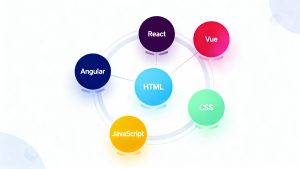In the ever-evolving landscape of web and software development, aspiring full stack developers face a crucial question: which programming languages should they master to thrive in 2025? With digital transformation accelerating across industries, the ability to build both the user-facing (frontend) and server-side (backend) components of applications is more valuable than ever. This comprehensive guide highlights the top 10 programming languages for full stack development, their unique strengths, and practical advice for selecting the right tools for your career path.
Understanding Full Stack Programming
Full stack programming is the art of crafting complete web or mobile applications by handling both the client-side (what users interact with) and the server-side (where data is processed and stored). A full stack developer is adept at multiple programming languages, frameworks, and tools, enabling them to construct seamless digital experiences from start to finish.
By mastering both frontend and backend technologies, full stack developers can bridge the gap between design and functionality, ensuring that applications are robust, scalable, and user-friendly. This versatility makes them highly sought after in tech startups, large enterprises, and freelance markets.
Why Language Selection Matters
Selecting the right programming languages for full stack development is not just about technical proficiency—it’s about career flexibility and opportunity. Here’s why language choice is critical:
- Employability: Knowledge of in-demand languages opens doors across tech and non-tech sectors.
- Freelance Potential: Diverse language skills attract more clients and project opportunities.
- Startup Agility: Founders and early-stage teams can build minimum viable products (MVPs) faster with the right stack.
- Scalability: Choosing proven languages ensures applications can grow with user needs.
With these benefits in mind, let’s explore the top 10 languages shaping full stack development in 2025.
The Best 10 Languages for Full Stack Programming
1. JavaScript
JavaScript is the cornerstone of modern web development. It powers both the frontend—through frameworks like React, Angular, and Vue—and the backend, thanks to Node.js. This dual capability makes JavaScript indispensable for full stack developers.
- Frontend: React, Angular, Vue
- Backend: Node.js
- Database: MongoDB (with full stack JavaScript)
- Use Case: Web apps, real-time features, APIs
2. Python
Python’s simplicity and versatility make it a favorite for beginners and experts alike. It excels in web development, data science, and automation.
- Frontend: Works with HTML/CSS and JavaScript
- Backend: Django, Flask
- Use Case: AI applications, dashboards, automation tools
3. Java
Java remains a powerhouse in enterprise environments, known for its stability and scalability.
- Frontend: JSP, or integration with JavaScript frameworks
- Backend: Spring Boot, Hibernate
- Industries: Banking, insurance, retail
4. TypeScript
TypeScript, a typed superset of JavaScript, enhances code quality and maintainability for large-scale projects.
- Frontend: React, Angular
- Backend: Node.js, Express.js
- Use Case: Scalable web applications, teams
5. PHP
PHP continues to be a reliable choice for server-side logic, especially in content management systems (CMS) like WordPress.
- Frontend: HTML/CSS
- Backend: Laravel, Symfony
- Best For: Blogs, CMS, eCommerce platforms
6. Ruby
Ruby, paired with the Ruby on Rails framework, is celebrated for its elegant syntax and rapid development cycle.
- Frontend: JavaScript
- Backend: Ruby on Rails
- Use Case: SaaS products, internal tools
7. C#
C# is widely used in enterprise and desktop applications, but it also supports web development through ASP.NET.
- Frontend: Blazor, integrates with JavaScript
- Backend: ASP.NET Core
- Industries: Finance, education, healthcare
8. Go (Golang)
Go, or Golang, is gaining traction for its performance, simplicity, and concurrency support.
- Frontend: HTML/CSS/JavaScript
- Backend: Pure Go, Gin framework
- Best For: High-performance systems, microservices
9. Kotlin
Kotlin is a rising star, especially for Android development, but it also shines on the backend with frameworks like Ktor and Spring.
- Frontend: Paired with JavaScript or cross-platform tools
- Backend: Ktor, Spring
- Use Case: Android and web full stack apps
10. SQL
While not a traditional programming language, SQL is essential for managing and querying databases—a core skill for any full stack developer.
- Use: Data retrieval, report generation, backend logic
- Works With: PostgreSQL, MySQL, SQLite
Essential Tools for Full Stack Developers
Beyond programming languages, full stack developers rely on a suite of tools and frameworks to streamline their workflow:
- Frontend Tools: HTML, CSS, JavaScript, React
- Backend Tools: Node.js, Express, Django, Spring Boot
- Databases: MongoDB, MySQL, PostgreSQL
- Version Control: Git, GitHub
- APIs: REST, GraphQL
These tools complement language expertise, enabling developers to build, test, and deploy applications efficiently.
How to Choose the Right Languages for Your Goals
Selecting the best languages for full stack development depends on your career aspirations and the industries you wish to enter. Here’s a quick guide:
- Beginners: Start with JavaScript and Python for a solid foundation.
- Enterprise Jobs: Focus on Java or C# for stability and scalability.
- Startups: Embrace JavaScript (Node.js + React) or Ruby on Rails for agility.
- Mobile + Web: Consider Kotlin with React or explore Flutter with Firebase for cross-platform solutions.
Final Thoughts: Charting Your Full Stack Journey
In 2025, the demand for full stack developers who understand both frontend and backend development will only grow. By mastering the languages and tools outlined in this guide, aspiring developers can position themselves for success in a competitive job market. Whether you’re launching a startup, freelancing, or joining a tech team, the right language stack will empower you to build innovative, scalable, and user-centric applications.
Read more such articles from our Newsletter here.



